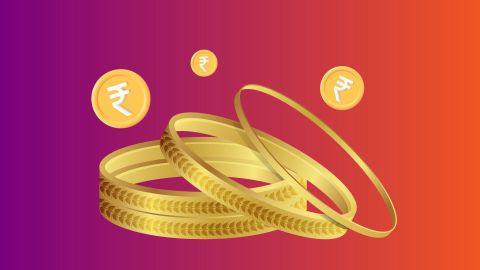2 mins
14 November 2024
Gold investment offers a safe way to grow wealth, whether through physical assets or digital forms. For Indian investors, choosing between physical gold and paper gold involves understanding the nature of each, potential returns, and tax implications. This article explores these differences, helps investors decide on the best option, and explains the process of securing a gold loan using gold as collateral. With a comprehensive comparison of pros and cons, readers can gain insight into whether physical or paper gold aligns better with their financial goals.
What is physical gold?
Physical gold refers to tangible gold assets like coins, bars, and jewellery. This type of investment provides real, holdable value. Indian investors have long trusted physical gold for its cultural significance and reliable store of wealth. Many prefer it for security and personal control, ensuring they can access their asset directly whenever needed. However, storage and insurance may require extra costs. Physical gold is also slightly illiquid, as selling and buying entail particular procedures. Regardless, physical gold remains an enduring choice for those seeking a valuable, tangible asset.
Paper gold, like ETFs or sovereign gold bonds, lacks physical form, making it unsuitable for direct collateral. However, some banks may consider certain paper gold assets under specific conditions. Therefore, if you are looking to secure a gold loan, physical gold remains the more viable option.
Paper gold vs. physical gold: Differences
| Aspect | Physical Gold | Paper Gold |
| Tangibility | Physical asset (coins, bars, jewellery) | Non-physical, digital or derivative forms |
| Storage Requirements | Needs secure storage | No storage necessary |
| Liquidity | Moderately liquid | Highly liquid |
| Transaction Costs | Higher due to making and storage charges | Lower transaction costs |
| Ownership | Direct ownership | Indirect through financial instruments |
| Security | Risk of theft, needs insurance | Safe from theft |
| Long-Term Benefits | Significant value in Indian culture | Market-driven, ideal for quick trades |
Should you invest in paper gold or physical gold?
Investing in paper or physical gold depends on individual financial goals and preferences. Here’s a quick guide to help make the right choice:- Liquidity requirements: For quicker transactions, paper gold is ideal.
- Storage concerns: If you lack secure storage, opt for paper gold.
- Cultural value: Physical gold is preferable if cultural significance matters.
- Tax implications: Paper gold often involves different tax structures.
- Investment horizon: For long-term gains, both options have potential depending on market trends.
Pros and cons of paper gold vs. physical gold
| Criteria | Pros of Physical Gold | Cons of Physical Gold | Pros of Paper Gold | Cons of Paper Gold |
| Storage | Tangible asset | Requires secure storage | No storage cost | No physical possession |
| Liquidity | Appreciated culturally in India | Lower liquidity compared to paper gold | High liquidity | Not culturally significant |
| Security | Provides direct ownership | Prone to theft or loss | Theft-proof | Market-dependent |
| Transaction Cost | Can be self-owned | High making charges | Minimal fees | Digital-only form |
| Loan Eligibility | Eligible for gold loans | Subject to storage requirements | Generally not accepted | Limit |
How to choose between paper gold and physical gold?
Choosing between paper gold and physical gold depends on your goals, investment horizon, and storage capabilities. Physical gold provides cultural and emotional value, essential for many Indian investors. It’s ideal if you seek a stable, tangible asset with long-term value. However, those preferring convenience and ease of transactions may choose paper gold. Its liquidity and minimal transaction fees make it attractive to younger investors with a shorter investment horizon. Carefully evaluate storage, liquidity needs, and personal preferences to select the right option.Tax implications of paper gold vs. physical gold
Understanding the tax treatment of physical and paper gold is crucial for informed investment. Physical gold held over three years is subject to long-term capital gains tax with indexation benefits, while short-term gains are taxed according to the investor’s income slab. In contrast, paper gold, including ETFs and sovereign bonds, attracts capital gains tax after three years but may offer indexation benefits, similar to physical gold. The annual income from sovereign gold bonds may also be taxable, depending on the interest earned. Consulting a tax advisor can provide further clarity.Can you use physical gold collateral for a gold loan?
Physical gold can indeed be used as collateral to secure a gold loan. Many Indian financial institutions, including Bajaj Finance, accept gold jewellery, bars, and coins as collateral. This makes it easier for investors to access quick funding without liquidating their assets. Gold loans are secured by the physical gold held by Bajaj Finance, allowing investors to retain ownership while receiving necessary funds. This method provides a solution for immediate liquidity needs while maintaining asset security and value. Physical gold loans are highly accessible to most investors.How to apply for a gold loan with paper gold or physical gold?
A gold loan application varies between paper and physical gold. For physical gold, visit a Bajaj Finance branch with your asset, where it will be evaluated, and your loan amount determined based on purity and weight. Paper gold, such as ETFs or sovereign bonds, may not be widely accepted as collateral. Here’s a step-by-step guide for a physical gold loan:- Evaluation: Bring gold to a Bajaj Finance branch for valuation.
- Loan offer: Receive a loan offer based on gold’s purity.
- Document verification: Submit ID and address proof for verification.
- Loan disbursement: Receive funds post-approval.
Is a gold loan possible against paper gold?
Obtaining a gold loan against paper gold is typically challenging. Bajaj Finance offers gold loan against physical gold jewellery due to its tangible nature and ease of valuation. You can get a loan of up to Rs. 2 crore against 18-22 karat gold jewellery.Paper gold, like ETFs or sovereign gold bonds, lacks physical form, making it unsuitable for direct collateral. However, some banks may consider certain paper gold assets under specific conditions. Therefore, if you are looking to secure a gold loan, physical gold remains the more viable option.
Frequently asked questions
Which is better, physical gold or paper gold?
The choice between physical and paper gold depends on individual goals. Physical gold holds cultural significance in India and offers a tangible, secure asset. However, it requires storage and can have high transaction costs. Paper gold, such as ETFs or sovereign bonds, provides easy liquidity, lower costs, and flexibility for quick trades. If you prefer a stable, long-term asset, physical gold is ideal, while paper gold suits investors seeking convenience and easy trading options.
What are the disadvantages of paper gold?
While paper gold offers convenience and lower costs, it has some drawbacks. It lacks the cultural and emotional significance of physical gold, making it less appealing to traditional investors. Additionally, it does not offer the same direct security or sentimental value. Paper gold is also subject to market volatility, which may impact returns. Furthermore, paper gold investments cannot be used as collateral for loans with many financial institutions, limiting its flexibility.
Can I convert paper gold to physical gold?
Converting paper gold to physical gold isn’t generally possible. Paper gold, like ETFs or sovereign gold bonds, is traded electronically and does not represent a physical asset you can retrieve. This is unlike digital gold, which some providers allow to be exchanged for physical gold. However, converting ETFs or sovereign gold bonds to actual gold bars or coins is typically not an option. Investors should choose between paper and physical gold based on their preferences for tangible assets.
What is the ratio of paper gold to real gold?
Paper gold generally represents an equal value to physical gold, but it doesn’t imply a one-to-one backing with physical reserves. For example, in ETFs, one unit of paper gold often equals one gram of gold in value. However, it’s crucial to note that paper gold does not require equivalent physical gold storage, as it’s not necessarily backed by actual gold holdings. The ratio is mostly symbolic, tied to gold’s market price, without physical assets tied to each unit.
Show More
Show Less
Bajaj Finserv App for All Your Financial Needs and Goals
Trusted by 50 million+ customers in India, Bajaj Finserv App is a one-stop solution for all your financial needs and goals.
You can use the Bajaj Finserv App to:
Apply for loans online, such as Instant Personal Loan, Home Loan, Business Loan, Gold Loan, and more.
You can use the Bajaj Finserv App to:
Apply for loans online, such as Instant Personal Loan, Home Loan, Business Loan, Gold Loan, and more.
- Explore and apply for co-branded credit cards online.
- Invest in fixed deposits and mutual funds on the app.
- Choose from multiple insurance for your health, motor and even pocket insurance, from various insurance providers.
- Pay and manage your bills and recharges using the BBPS platform. Use Bajaj Pay and Bajaj Wallet for quick and simple money transfers and transactions.
- Apply for Insta EMI Card and get a pre-approved limit on the app. Explore over 1 million products on the app that can be purchased from a partner store on Easy EMIs.
- Shop from over 100+ brand partners that offer a diverse range of products and services.
- Use specialised tools like EMI calculators, SIP Calculators
- Check your credit score, download loan statements, and even get quick customer support—all on the app.






